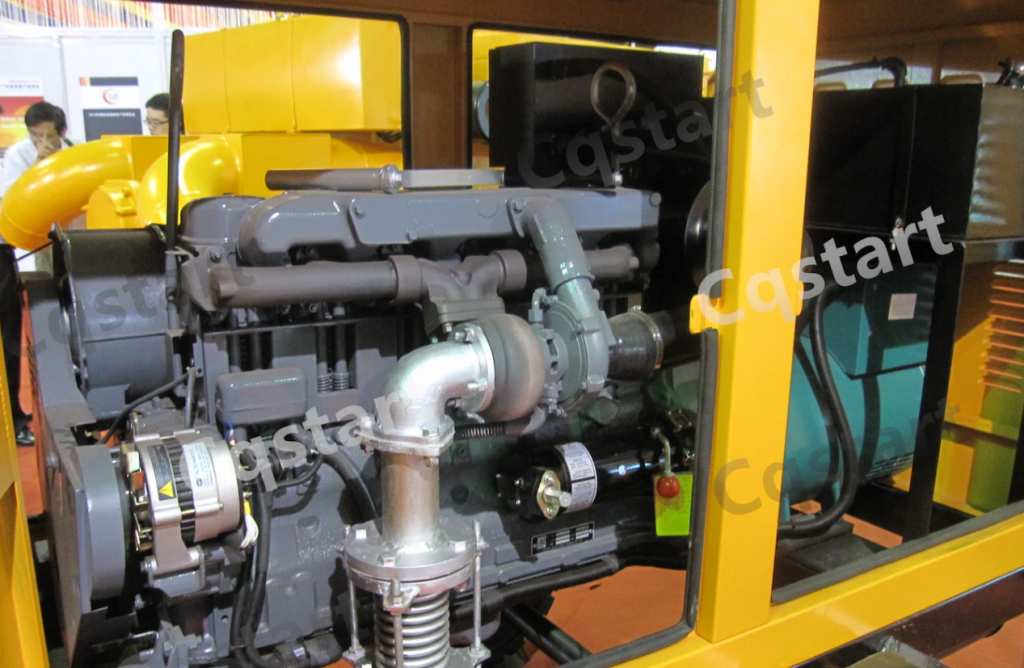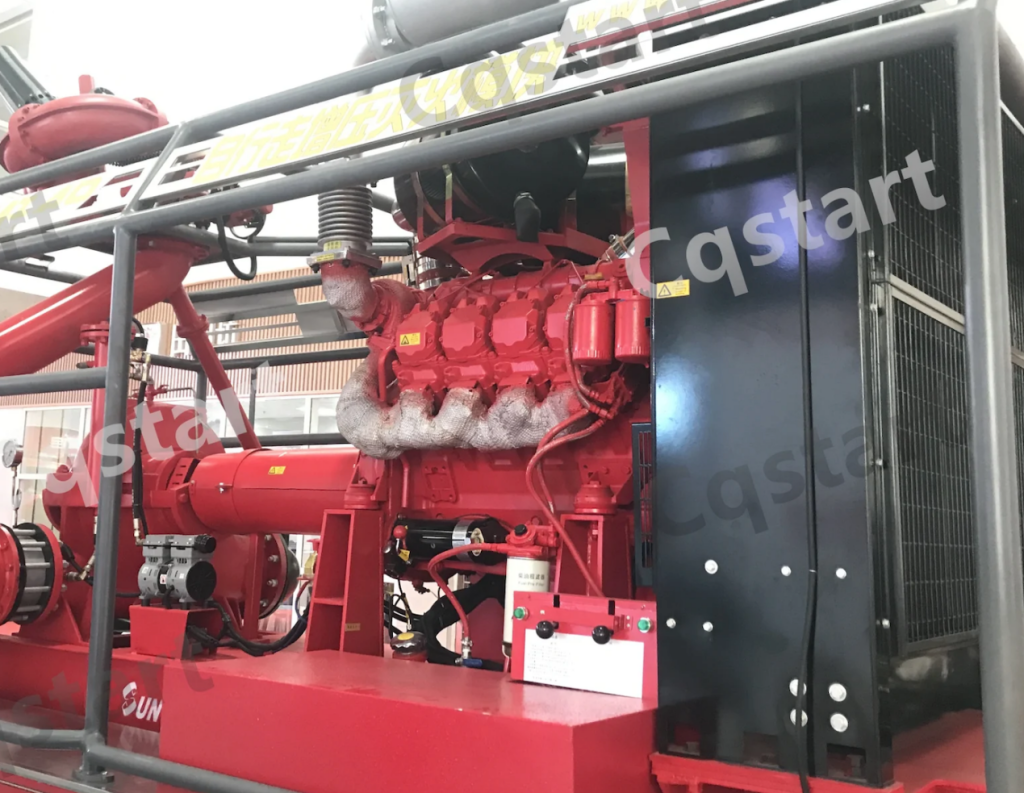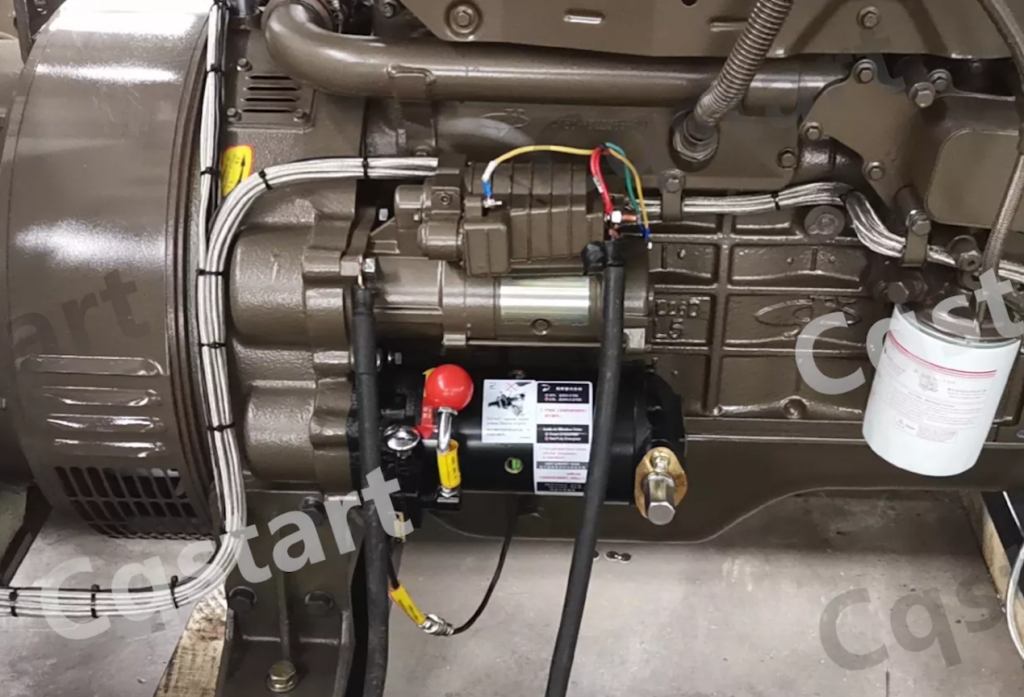In the event of a power outage or emergency, an emergency generator can provide critical power supply for homes, hospitals, factories, or data centers. However, many people only realize during urgent situations that they are not familiar with the correct method of how to start an emergency generator.
This article will provide you with clear operating steps on how to start emergency generator and safety precautions. It will also introduce a spring starter, a reliable and durable device that requires no battery, helping you restore power quickly and safely when it matters most.
Part 1. What’s the Preparation Before Starting Emergency Generator?
Before you ever pull a recoil cord, or press an electric start button, take a minute to prep. These checks prevent damage, reduce safety risks (especially carbon monoxide), and help the generator come online smoothly so your critical loads aren’t hit with sudden surges.
1. Check the Fuel
- Confirm fuel type: Gasoline, diesel, or LPG/propane—verify the label and your manual so you don’t mix fuels.
- Quantity: Make sure there’s enough for your expected runtime; top up if needed. Open the fuel shutoff valve (for gasoline units) or confirm the LPG cylinder and regulator are securely connected.
- Quality: Stale gasoline (often >3 months old without stabilizer) can cause hard starts and rough running. For diesel, look for water contamination or unusual odor. Replace questionable fuel and purge lines as needed.
- Leaks & odors: Do a quick sniff/visual check around the tank, lines, and fittings. Fix any leaks before proceeding.
2. Check Engine Oil and Coolant
- Oil level: Use the dipstick; top up with the grade specified in the manual. If the oil looks thick/dirty or you’re past the change interval, change it first.
- Coolant (liquid-cooled models): Check the radiator/overflow tank level; never open a hot radiator cap. For air-cooled units, ensure cooling fins and shrouds are clean and unobstructed.
- Temperature readiness: In very cold or hot weather, confirm you’re using season-appropriate oil and coolant mixtures for reliable starting and proper lubrication.

3. Check Ventilation and Placement
Run outdoors or in a space with active exhaust ventilation: Never operate in garages, basements, or enclosed patios. Carbon monoxide is odorless and deadly.
- Positioning: Place the generator on a level, dry surface with the exhaust pointing away from doors, windows, and air intakes. Keep clear of combustible materials and allow ample airflow around the unit.
- Safety add-ons: If possible, use CO detectors nearby and weather protection designed for generators (while maintaining ventilation and keeping electrical components dry).
4. Check Cables and Loads
- Connections: Inspect power cords for damage, use the correct gauge/length, and ensure proper grounding. If you’re using a transfer switch or interlock, confirm it’s installed and set correctly to prevent backfeed to the grid.
- Breakers & loads: Set the generator’s output breaker(s) to OFF and turn all connected loads OFF before starting. After the generator warms up, switch the generator breaker ON and add loads gradually—priority circuits first (e.g., medical devices, sump pumps), then others.
- Sensitive electronics: Use surge protection or a UPS for computers, servers, or medical equipment to smooth out startup fluctuations.
Part 2. How to Start Emergency Generator?
Follow these steps to bring the generator online smoothly and safely. Adjust as needed for your specific fuel type and model.
Step 1. Turn Off All Loads
Unplug appliances and switch off the main load breaker/transfer switch circuits.
Goal: prevent a start-up surge from stalling the engine or tripping breakers.
Step 2. Open the Fuel Supply
Gasoline: Move the fuel valve to ON; if there’s a primer bulb, press it 3–5 times.
Diesel: Ensure the fuel cock/solenoid is ON and there’s no air in the line (bleed if you previously ran out of fuel).
LPG/Propane: Open the cylinder valve fully, check the regulator and hose connections for leaks (sniff/soapy water test).
Step 3. Set Choke / Air Control (Cold Starts)
Gasoline (carbureted): Move the choke to CHOKE (closed) for a cold engine; for warm restarts, set it halfway or RUN (open).
Diesel & LPG: Typically no choke; for diesel, use glow plug/heater if equipped—turn key to the preheat position and wait for the indicator light to go out.

Step 4. Start the Engine
Recoil (pull-start):
- Turn the engine switch to ON.
- Pull the cord slowly to engage, then pull briskly. Repeat with short rests; don’t yank continuously.
Electric start:
Battery switch ON. Hold the key or start button for up to 5–8 seconds; if it doesn’t catch, pause 15–30 seconds and try again to avoid overheating the starter.
- Rotate the handle to wind the internal spring until the charge indicator or resistance point is reached.
- Confirm fuel and air settings are correct (diesel preheat done, choke set for gasoline).
- Release the trigger to deliver a high-energy spin to the crankshaft. No battery required—ideal for low-temperature diesel starts or when the battery is weak.
Step 5. Stabilize / Warm Up
- Let the engine run 1–2 minutes with no load.
- Gradually move the choke from CHOKE to RUN as the engine smooths out (gasoline).
- Listen for smooth RPM; check for abnormal vibration, fuel/oil leaks, and verify output voltage/frequency if your panel shows it.
Step 6. Add Load Gradually
- Flip the generator’s output breaker ON, then energize circuits step by step.
- Start with critical loads (medical devices, sump pumps, servers), then add other appliances in stages.
- Avoid starting multiple high-surge loads at once (A/C, well pumps); space them out by 20–30 seconds.
- Keep total load within the generator’s rated output (for long runs, ~70–80% is a good target).
Tip (Diesel Units): Preheating matters—use glow plugs or intake heaters, allow a slightly longer warm-up (2–3 minutes in cold weather), and consider winter-grade fuel/anti-gel when temperatures drop.
Part 3. Why Choose a Spring Starter for Emergency Generators?
In critical situations, a generator’s electric starter may fail due to a drained battery, wiring faults, or lack of regular maintenance. A spring starter (mechanical spring-driven starter) offers a highly reliable alternative. Here’s why it stands out:
No Battery Required
- A spring starter relies entirely on stored mechanical energy rather than a battery or alternator.
- This eliminates the risk of battery discharge during long storage periods, a common issue with standby equipment.
- Even if the generator hasn’t been used for months, the spring starter remains ready for action.
Reliable and Durable
- Built with a rugged, all-mechanical design, it has fewer failure points compared to electrical systems.
- It’s specifically suited for emergency and backup generators that may sit idle for long periods but must perform instantly when called upon.
- Operators can trust it to deliver consistent cranking power without worrying about electronic failures.

Adaptable to Harsh Environments
- Performs reliably in extreme conditions such as low temperatures, humid climates, or remote areas where batteries quickly lose charge or replacements are hard to find.
- This makes it especially valuable for diesel emergency generators in outdoor, offshore, or field-deployed scenarios.
Low Maintenance
- With virtually no electrical components, maintenance is minimal—typically just periodic inspection and occasional lubrication.
- No need for battery checks, charging systems, or spare parts stocking, reducing both operational cost and downtime.
- For many diesel emergency generators, equipping a spring starter is a cost-effective safeguard. It ensures that when the grid fails, you always have a dependable way to bring your generator online, no matter the conditions.
Part 4. Safety Tips for Starting and Operating an Emergency Generator
While learning how to start an emergency generator, safety must always remain the top priority. A generator can be a lifesaver in power outages, but improper use may lead to serious accidents, equipment damage, or even health hazards. Keep the following guidelines in mind:
1. Never Operate in Enclosed Spaces
Running a generator indoors or in poorly ventilated areas (such as garages, basements, or sheds) can quickly lead to a dangerous buildup of carbon monoxide (CO)—a colorless, odorless gas that can be fatal.
Always operate the generator outdoors in an open area, or ensure proper exhaust ventilation systems are in place.
Consider installing CO detectors in nearby living or working spaces for added safety.
2. Avoid Overloading the Generator
Each generator has a maximum rated output. Exceeding this limit can cause overheating, tripped breakers, or permanent damage to both the generator and your appliances.
Distribute loads carefully by prioritizing essential devices first (medical equipment, lighting, refrigerators), then gradually adding others.
Use surge protection for sensitive electronics to prevent damage from voltage fluctuations during startup or load changes.
3. Use Spring Starter Safely
When starting with a spring starter, always make sure the transmission or gear is in the correct position before releasing the spring’s stored energy.
Hold the handle firmly and release it in a controlled manner to prevent kickback or rebound injuries.
Familiarize yourself with the device in advance—practice in non-emergency conditions so you can operate confidently when it truly matters.
4. Perform Regular Maintenance
Check engine oil, coolant (if applicable), and fuel condition periodically, even if the generator is rarely used.
Inspect air filters, fuel lines, and cables for wear or leaks. Replace or repair components as needed.
Test-run the generator at least once a month under light load to ensure all systems (including electric or spring starters) remain operational.
For spring starters, occasional inspection and lubrication are enough to keep them reliable for long-term standby use.
5. Importance of Regular Drills
Many people only look up how to start an emergency generator when the lights go out, which wastes precious time. Scheduled drills build muscle memory, expose hidden issues, and keep everyone calm under pressure.
6. Respond faster under stress
Rehearse the exact sequence: fuel → air/choke or preheat → start (recoil/electric/spring starter) → warm-up → gradual load. Time the drill and aim for smooth, error-free execution.
7. Master all start methods (including spring starter)
Practice with recoil, electric start, and the spring starter. Simulate a dead-battery scenario so operators can confidently wind, arm, and release the spring starter without hesitation or kickback.
8. Find problems early—before an outage
Do a monthly test run under load long enough to reach operating temperature (often 20–30 minutes). Watch for unstable RPM, abnormal noise, leaks, tripped breakers, or transfer-switch issues. For diesels, loaded runs help prevent wet-stacking.
9. Validate fuel and fluids strategy
Rotate stored fuel, check for contamination (water/algae in diesel, stale gasoline), confirm oil/coolant levels, and inspect filters and hoses. Verify shutoff valves, regulators, and priming procedures.
10. Reinforce safe setup
Drill the placement (outdoors, ventilated), CO awareness, correct cable gauge/length, grounding, and staged load-on to avoid overloads and voltage dips.
11. Document roles and checklists
Keep a laminated step-by-step checklist at the generator, plus a logbook for drill dates, findings, and fixes. Assign primary and backup operators; note where keys, tools, and spare parts are stored.
12. Train backups and vary scenarios
Rotate personnel; run day/night and cold-weather drills; include “remote site” and “battery failed” scenarios. Ensure at least two people can independently start and load the unit.
13. Debrief and fix
After each drill, capture what went well, what failed, and assign corrective actions with deadlines. Then, re-test to confirm the fix.
Summary
Learning how to start an emergency generator is simple but essential. Always check fuel, oil, and ventilation first, then use the right startup method – pull the cord, electric, or the reliable spring starter. Follow safety rules, avoid overloading, and practice regularly to keep it ready. An emergency generator is your lifeline, and a spring starter ensures it works anytime. For dependable spring starter solutions, contact Cqstart for safe, durable, and efficient support.

